Mary Delaney’s husband, Joe, was coming around the barn with a load of firewood when he saw the boars staring at him from behind the sawmill. Scary, if he’d had time to think about it. All those coarse, heavy bodies, tusks and teeth like sharpened knives.
For a moment, everything was still. Then it wasn’t.
“I call it the ‘ET in the cornfield moment,’” Ms. Delaney would say later. “They look at each other, and then everybody yells and throws up their hooves or their hands or whatever. Joe comes running to me, and the boars turned and ran the other direction. And he goes – I won’t use all the words he used – but he goes, ‘They’re right there! There’s a whole bunch of them, and they’re right there!”
Ms. Delaney is an environmentalist who has dedicated decades of her life to protecting the unique federal lands on which she and Joe live in north Pickering, Ont., a swath of park and farmland expropriated by the government in the 1970s, but so far, never developed. Caring as she does about that area, and about the natural world more broadly, she and Joe read and watch programs about the environment often, learning everything they can about animals, the climate and invasive species.
Still, until a nice young man showed up at the door with a pamphlet about wild boars – and until Joe came face to face with them in the yard that day last fall – Ms. Delaney was, like many of us, blissfully unaware of wild boars in Canada or, for that matter, the role they would come to play in her life.
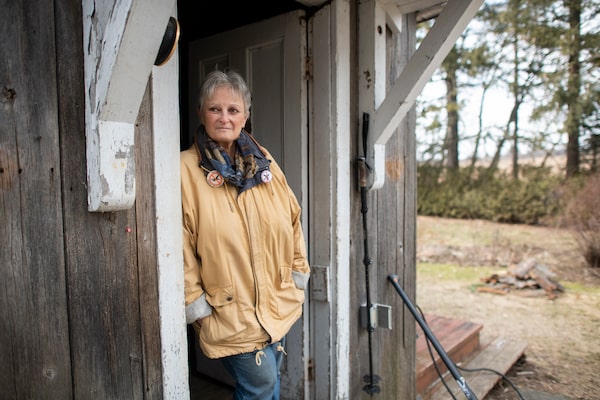
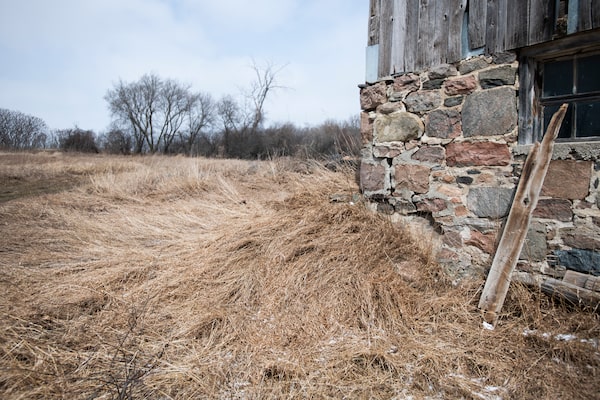
Mary Delaney and the corner of the barn on the property in north Pickering where her husband, Joe, found wild boars.Fred Lum/The Globe and Mail
Of course, once you start to notice, there are wild boar stories everywhere. Wild boars were in Alberta’s Elk Island National Park. Irradiated wild boars were roaming Fukushima and Chernobyl. Boars were trotting down the streets of Rome. They were tearing up yards in New Orleans, ripping up vineyards in Napa. There was the viral photograph of a naked man at a beach in Germany, flesh flying as he chased a boar running away with his laptop. There was the woman killed on the doorstep of a home in rural Texas. Cause of death: “exsanguination due to feral hog assault.”
There was popstar Shakira, strolling through a park in Barcelona with her son, when two wild boars charged and snatched her bag, fleeing into the woods with her phone and car keys and everything else she’d been carrying in a way that felt so strangely personal it was, she told Glamour magazine, “like they could understand me.”
Wild boars are, present company excluded, the single most invasive, adaptable and destructive mammals on the planet. They can live pretty much anywhere, eat pretty much anything. They are devastating to waterways, disastrous to agriculture, insatiable predators that can bring down a deer, decimate bird populations and threaten entire species. They are tough enough to survive the most extreme Canadian cold, smart enough to learn from the risk of humans and adapt. They spread dangerous bacteria such as e.coli and salmonella, and – the thing that strikes fear into anyone even remotely connected to the domestic pork industry – African Swine Fever.
“Only as this unfolded did I begin to understand what the potential threat really was. That it really was potentially an ecological-slash-environmental train wreck that could happen,” Ms. Delaney would say on the phone one afternoon.
By then, it had been a few months since Joe met the boars near the woodpile. It was after Ms. Delaney had pursued them down a gravel road and after they returned to root up her garden, after the stakeouts and the surveillance, after the sour corn and the sweet fluffernutters, and the eventual, bloody outcome. “These things are the ultimate adapters to their environment,” she said, with no small amount of awe in her voice. “They are incredible. I mean, you’ve got to admire them. But they don’t belong here.”
In May of 1990, the NATO Nuclear Planning Group met in the mountains of Kananaskis west of Calgary to discuss their nuclear arsenal, bearing in mind, The Globe and Mail noted then, “that the Soviet Union remains the greatest threat to peace in Europe.”
During the meeting, attendees sat down to a lavish meal of wild boar from a farm outside Edmonton.
At the time, Eurasian wild boar was a transformative agricultural product in Canada, a luxury livestock to be exported for already-primed palates in Asia, with the expectation of a growing appetite in Canada. Wild boar meat was flavourful and lean, and the animals were easy and resilient livestock. A “tough pig,” one 1990 Edmonton Journal headline trumpeted, that “practically raises itself.”
Wild boars were a good fit for bad farmland, and proved surprisingly hardy in Canadian conditions. Stories intended to demonstrate their mettle and vigor – a boar charging a bison, a sow birthing alone in -34 C and not losing a single one of her young – would later read like foreshadowing.
There were signs of trouble almost immediately. Wild boars proved adept at escape, and, with the intelligence of pigs combined with the canny ferocity of animals gone feral, rapidly became a nuisance to neighbouring farms and ranchlands.
Some blamed fly-by-night farmers looking to cash in on a booming commodity, but even responsible ranchers had trouble keeping them contained. There’s an old adage that “there’s no such thing as a pig-proof fence,” and once loose, their cousins the wild boar were proving destructive, unpredictable and even more difficult to recapture.
By the late 1990s, as wild boar farms approached the height of their popularity in Canada, interactions with escaped boars were increasingly common, and consistently astonishing for those who encountered them.
“I couldn’t believe it. I thought I’d stepped into the Middle Ages,” a man named Foster Walker told the Calgary Herald, after bumping into some boars along the Rosebud River in southern Alberta in the spring of 1999.
“I was raised on a farm and know what a pig looks like,” Marianne Dueck told the Edmonton Journal, having narrowly avoided a creature on the highway outside Edmonton. “Believe me, this was no normal pig.”
In Edmonton, police pursued a wild boar along the vein of river valley running through the city and shot it dead on the grounds of Government House. In Manitoba, more than 100 wild boars encroached on the Crocus Grove Nudist Resort, having escaped from a farm during a flood. In Ontario, an officer pursued and finally dispatched a “renegade 135 kilogram wild boar” after a weeklong hunt near Orillia, during which the boar terrorized cottagers, charged at teens and police, and at one point escaped capture by swimming away through Penetang Harbour.
By 2001, there were 32,000 wild boars at 500 farms across Canada. It was clear even one escaped animal posed a serious risk to people and property, and could do an immense amount of damage before being recaptured or killed.
Then, as the market for wild boar meat dried up, some farmers simply opened the gates and let them run.
To think about wild boars is to consider the very essence of human interaction with the natural world, and the relationship between human and pig is one of the most complex and storied in the history of both species.
In mythology it was a wild boar that turned on Adonis as he hunted, leaving him bleeding to death in the arms of the goddess Aphrodite. In fairy tales, it was a wild boar – sometimes called The Pig King – that seduced a woman, a romance that would become known as Beauty and the Beast.
Wild boars are a great, menacing threat in The Odyssey, Old Yeller and Lord of the Flies. “Beautiful Monsters,” the poet Robinson Jeffers called them in 1937. The poem describes a man stocking a hunting park with wild boars, only to have them break free and ravage the land.
The purest Eurasian wild boars are black and coarse, with long snouts and a short, straight tail. They are brawnier than their cousins the barnyard pig, hind ends rising into a powerful scruff of muscle around the neck and shoulders. Their coat is thick, with heavy bristles along nape and back.
In North America, feral swine populations are usually some combination of true Eurasian wild boars and escaped domestic pigs, and the varied look of wild pigs in Canada reflects this mixed genealogy.
Ryan Johnstone joined the wild pig team with the Ontario Ministry of Northern Development, Mines, Natural Resources and Forestry in 2021, after a lull in his usual work with migratory birds. He knew there were serious wild boar problems in the United States, but he hadn’t heard much about them in Canada, and thought the conditions probably wouldn’t support the same kind of population growth. Six months into the job, he knew he was wrong.
But while wild pigs were becoming an increasingly urgent issue on the prairies, the file in Eastern Ontario remained uneventful. The reports Mr. Johnstone investigated turned out to be mistakes or one-offs, such as someone’s potbelly wandering away from the yard.
In early November, Mr. Johnstone was occupying himself with disease surveillance in whitetail deer when a new boar report came in. The video was blurry. Then a picture came through. Mr. Johnstone could see right away they were definitely true wild boars. There were eight of them. One had the striping of a piglet.
“Oh no,” he thought.
Where they’d come from was a mystery. The province had recently announced it would be phasing out wild boar farming and banning the animals as livestock. That the boars were spotted in daylight implied they were domesticated and had been newly introduced into the wild, whether by accident or on purpose. Either way, Mr. Johnstone knew how fast a few breeding-aged boars could get out of control.
He immediately headed to where they’d been spotted around Pickering. He spent the rest of the day travelling from property to property introducing himself, passing out pamphlets and asking residents to call him if they saw any sign of boar activity. Ms. Delaney was the last person he spoke to that day.
Four days later, her number popped up on his phone.
:format(webp)/cloudfront-us-east-1.images.arcpublishing.com/tgam/FSDWAVT2IZFK7F2R55LVEKJ5VE.JPG)
:format(webp)/cloudfront-us-east-1.images.arcpublishing.com/tgam/JHL7RLXBRVCJDPRWZ4DABKSRIA.jpeg)
Pigs were first introduced to North America by the Spanish in the 1500s, and wild populations have existed – and caused problems – to varying extents on the continent ever since.
In the United States, the situation changed significantly in the 1970s and 1980s, when game departments began actively promoting wild boar hunting for sport. Soon, there were feral wild boar populations established in 48 of 50 states. At first, no one was concerned.
“Back when I started all this, wild pigs weren’t evil,” says John Mayer, a researcher and manager at the Savannah River National Laboratory in South Carolina.
But no one had any idea how destructive they were, or how quickly they could breed.
Wild pigs live and travel in groups called sounders, made up of a mature female and generations of her offspring. Breeding-age males travel between sounders over ranges that can span hundreds of kilometres, mating with any females ready to breed.
Pigs eat broadly and indiscriminately – plants and vegetables, meat and eggs, grubs, mushrooms and berries – based on preference and availability. A single animal can easily grow to several hundred pounds in the wild.
Georgia’s famed “Hogzilla” was estimated to weigh 800-1,000 pounds when he was killed in 2004, and was identified by genetic testing as a mix of domestic pig and wild boar. (A 1,000 pound “Monster Pig” shot in Alabama in 2007 and purported to be the largest wild boar on record was later found to have been a purchased domestic pig named Fred.)
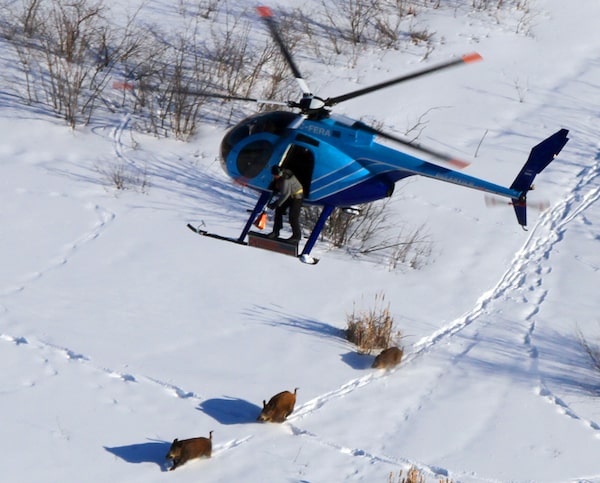
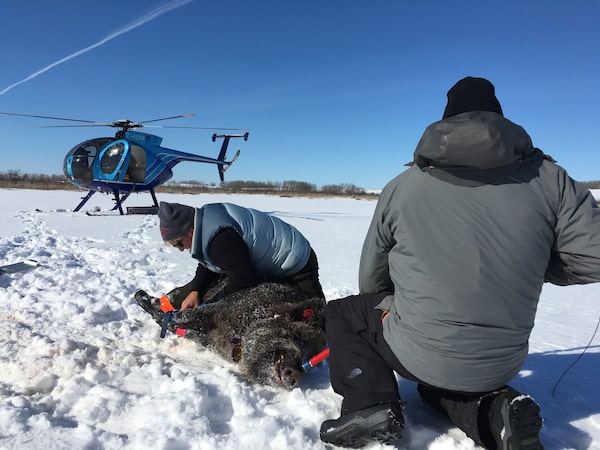
University of Saskatchewan research teams capture wild pigs in the winters of 2016, top, and 2017, so they can be tagged with GPS collars. The animals' size and strength makes live capture difficult.Ryan Brook/University of Saskatchewan
Wild boars are fast and clever, their hides tough enough that it takes both skill and firepower to fell them with a single shot. For an able hunter, they can feel like a worthy adversary – and a thrillingly dangerous one. Boar hunting spears have a stopper because an injured boar will turn and charge its attacker, even if it impales itself in the process.
As a wild boar exterminator told the Canadian Hog Journal last fall, “If you hurt one of them, they won’t stop until either you’re dead or they’re dead. That’s just the way it is.”
Couple this preternatural disinclination to extermination with an exuberant reproductive cycle – a wild sow can farrow two litters a year with an average of six piglets each, her first piglets nearing reproductive age by the time the second litter is born – and you start to glimpse the scope of the challenge.
“They are a very destructive, invasive species, but they are a fascinating animal,” Mr. Mayer says. “If you wanted to design the perfect pioneering – or in non-native areas, invasive – species, you wouldn’t have to look any further than the wild pig.”
The U.S. is estimated to have about seven million wild pigs, and currently spends well over US$2.1-billion a year trying to control the population and mitigate damage, a figure that doesn’t include ecological destruction and loss of ecosystems, which, if they were even calculable, would be many billions more.
John Kinsey, a research biologist in Texas, the epicentre in the battle against wild boars and hybrid feral pigs in the U.S., says you have to remove about 70 per cent of the population every year, just to keep it from growing.
“In Texas, estimates are that we remove approximately 29 per cent of the population,” he says. “We’re throwing everything we have at them down here, and we’re still coming up short.”
As Mr. Kinsey and his colleagues like to say, “There’s two types of people in the world: People that have pigs, and people that are about to have pigs.”
In Texas, the most effective approach has been aerial gunning, where marksmen shoot and kill entire sounders from the air. But this requires certain conditions, namely lots of wild pigs, sparse ground cover and no people.
Some countries use explosives or toxins. (Recently New Zealand and Australia – which by one estimate has 24 million wild pigs – have allowed the use of sodium nitrite.) Wild pigs can also be hunted with trained “hog dogs,” but in a sustained campaign, they start to get wise. In one eradication effort at a nuclear site near Augusta, Ga., Mr. Mayer said the pigs learned if they ran long enough, the dogs would give up.
“All we did was create a population of runners,” he says.
Hunting – even with open season and no limits – doesn’t reduce wild pig populations and can actually make the problem worse, turning them nocturnal and scattering sounders, increasing their roaming range and breeding potential.
Ryan Johnstone met Mary Delaney along the side of the road, and together they watched the wild boars. Now Mr. Johnstone saw there were 14, most of breeding age.
He’d seen almost every kind of animal there is in Canada, but there was something different about the boars. It was strange, almost like seeing a mythical creature.
He stayed for a long time, trying to gauge their weights and temperaments, looking at them as they lollygagged around in the grass, tearing up the ground, brawling and playing.
Ontario’s protocol for dealing with wild pigs involved baiting them until the whole sounder could be trapped, then euthanizing them by gunshot. The plan had been developed over two years, and this was the first opportunity to go through it step-by-step.
It had to work. Aerial shooting wasn’t an option in an agricultural landscape on the edge of suburbia, and Mr. Johnstone knew if the sounder was spooked or split up, the boars would become harder to catch, and have a greater chance of fully establishing in the wild. Trapping had to be done methodically and carefully. Taking down part of the sounder would only make things worse.
Ryan Brook, shown at his office on the University of Saskatchewan campus in Saskatoon, is one of Canada's foremost researchers of wild boars.Liam Richards/the Globe and Mail
From his office at the University of Saskatchewan in Saskatoon, Dr. Ryan Brook has spent more than a decade trying to warn anyone he could about wild pig populations in Canada. For a long time, it was hard to even get people to take his calls.
But he’d seen what happened in the United States, and knew it was a glimpse into the future.
Dr. Brook compares it to a fire, a cancer cell, something that starts small and grows quickly out of control. His graphs of wild pig populations in Canada recall the charts from the earliest days of the pandemic, exponential growth appearing deceptively flat at first, then dramatically arcing skyward.
“Two things surprised us: How many there were when we first started looking, and how fast this has exploded out of control,” says Dr. Brook, who heads the Canadian Wild Pig Research Project. “In some ways, we shouldn’t be shocked, but it is still overwhelming just how fast these animals have spread across the Canadian landscape and how bad it’s getting. And how far along we are.”

Public reports of wild pig occurrences
in Canada since 1995
4,500
4,000
3,500
3,000
2,500
2,000
1,500
1,000
500
0
1
5
10
15
20
25
Years
Note: Data includes phone calls, social media reports, and attending wildlife meetings with the public.
THE GLOBE AND MAIL, SOURCE: DR. RYAN BROOK,
UNIVERSITY OF SASKATCHEWAN

Public reports of wild pig occurrences
in Canada since 1995
4,500
4,000
3,500
3,000
2,500
2,000
1,500
1,000
500
0
1
5
10
15
20
25
Years
Note: Data includes phone calls, social media reports, and attending wildlife meetings with the public.
THE GLOBE AND MAIL, SOURCE: DR. RYAN BROOK,
UNIVERSITY OF SASKATCHEWAN

Public reports of wild pig occurrences in Canada since 1995
4,500
4,000
3,500
3,000
2,500
2,000
1,500
1,000
500
0
1
5
10
15
20
25
Years
Note: Data includes phone calls, social media reports, and attending wildlife meetings with the public.
THE GLOBE AND MAIL, SOURCE: DR. RYAN BROOK, UNIVERSITY OF SASKATCHEWAN
The picture of the wild boar problem in Canada is just starting to become clear. Wild pigs are among the hardest animals to find on the land, which makes them exceedingly difficult to track and count. And the thing about wild pigs is, once the problem is obvious, you’re already in deep trouble.
There’s no good estimate of how many wild pigs are in Canada, but between aerial surveillance, trail cameras, reports from the public, collaring, modelling and the experience of other countries, Dr. Brook can say with certainty the population is spreading completely out of control on the prairies, and without aggressive action, will get significantly worse.
He’s logged 60,000 occurrences in the past 20 years and predicts there could be, in the not-too-distant future, more wild pigs in Saskatchewan than people.

Wild pig occurrences in Canada,
by timeframe
1995 to 2003
Yukon
NWT
Nunavut
B.C.
Alta.
N.L.
Sask.
Man.
Que.
Ont.
N.B.
2004 to 2012
Yukon
NWT
Nunavut
B.C.
Alta.
N.L.
Sask.
Man.
Que.
Ont.
N.B.
2013 to 2021
Yukon
NWT
Nunavut
B.C.
Alta.
N.L.
Sask.
Man.
Que.
Ont.
N.B.
Note: Data includes public reports, interviews, phone calls, social media, media stories and trail cams.
MURAT YÜKSELIR / THE GLOBE AND MAIL, SOURCE:
DR. RYAN BROOK, UNIVERSITY OF SASKATCHEWAN

Wild pig occurrences in Canada, by timeframe
1995 to 2003
Yukon
NWT
Nunavut
B.C.
Alta.
N.L.
Sask.
Man.
Que.
Ont.
N.B.
2004 to 2012
Yukon
NWT
Nunavut
B.C.
Alta.
N.L.
Sask.
Man.
Que.
Ont.
N.B.
2013 to 2021
Yukon
NWT
Nunavut
B.C.
Alta.
N.L.
Sask.
Man.
Que.
Ont.
N.B.
Note: Data includes public reports, interviews, phone calls, social media, media stories and trail cams.
MURAT YÜKSELIR / THE GLOBE AND MAIL, SOURCE:
DR. RYAN BROOK, UNIVERSITY OF SASKATCHEWAN

Wild pig occurrences in Canada, by timeframe
1995 to 2003
Yukon
NWT
Nunavut
B.C.
Alta.
N.L.
Sask.
Man.
Edmonton
Vancouver
Que.
Calgary
Victoria
Charlottetown
Regina
Ont.
N.B.
Winnipeg
Halifax
Quebec
Ottawa
Toronto
2004 to 2012
Yukon
NWT
Nunavut
B.C.
Alta.
N.L.
Sask.
Man.
Edmonton
Vancouver
Que.
Calgary
Victoria
Charlottetown
Regina
Ont.
N.B.
Winnipeg
Halifax
Quebec
Ottawa
Toronto
2013 to 2021
Yukon
NWT
Nunavut
B.C.
Alta.
N.L.
Sask.
Man.
Edmonton
Vancouver
Que.
Calgary
Victoria
Charlottetown
Regina
Ont.
N.B.
Winnipeg
Halifax
Quebec
Ottawa
Note: Data includes public reports, interviews, phone calls, social media, media stories and trail cams.
Toronto
MURAT YÜKSELIR / THE GLOBE AND MAIL, SOURCE:
DR. RYAN BROOK, UNIVERSITY OF SASKATCHEWAN
Signs of wild pig destruction are starting to appear. Crop damage caused by wild boars will be eligible for compensation for the first time in Alberta this year, and the Saskatchewan Crop Insurance Corp. has already been paying out claims.
But the problems created by wild pigs are myriad, and as populations increase, so do other dangers. Pigs’ eyes aren’t reflective like other wildlife at night, which makes them particularly treacherous on darkened roadways. Vehicle collisions with wild pigs in the U.S. cost an estimated $181-million a year, in addition to the toll of injury and death.
Though researchers are careful not to overhype the risk of attacks on humans, there are a growing number around the world, including the woman killed in Texas in 2019.
Wild pigs killed 33 people globally in 2021, more than three times the number killed by sharks. In some parts of Rome, residents can’t have picnics or leave their homes at night, due to escalating wild boar aggression.
Many who’ve dealt with the creatures have, at one point or another, scrambled into a vehicle or up a tree for safety. Others wear jagged scars where a tusk tore through flesh.
Chinese husbandry and veterinary bureau workers in Jinhua, Zhejiang province, disinfect a pig farm to prevent African Swine Fever.Reuters
And then there’s African Swine Fever.
Even by the rosiest assessments, an outbreak of African Swine Fever in wild pigs could cripple the North American pork market, costing hundreds of billions of dollars, leading to the deaths of millions of domestic and wild pigs, and destabilizing not only the pork industry, but agriculture and food production more broadly.
African Swine Fever can have a 100-per-cent mortality rate in pigs. It lives for weeks in feces, and months on surfaces and in cured meat. An outbreak in the wild pig population is the stuff of nightmares. The scenarios are chillingly simple.
Alberta Pork programs manager Charlotte Shipp uses the scenario of a sausage with African Swine Fever ending up in a landfill and being eaten by a wild boar, which would then deposit the pathogen on fields and crops, where it could be passed back into domestic livestock through another animal or brought into a barn on a pair of boots.
“If African Swine Fever ever gets into North America, and gets into our wild pig populations, you can forget about eating bacon ever again,” said Mr. Mayer, in Georgia. “You’ll never be able to find it, much less afford to pay for it.”
He says some of his colleagues believe it’s only a matter of time.
:format(webp)/cloudfront-us-east-1.images.arcpublishing.com/tgam/PUCZPVA5INAVFGJWEF66PCIAQQ.jpg)
:format(webp)/cloudfront-us-east-1.images.arcpublishing.com/tgam/PYNULYTGJ5HVJMY46NEK3SUPTE.JPG)
:format(webp)/cloudfront-us-east-1.images.arcpublishing.com/tgam/DKG4IK32UVABFEQFBHH6ZSWXFQ.JPG)
Mr. Johnstone’s plan to capture the wild boars in Pickering had three steps: Find them, learn their patterns, and trap them. Pigs are cautious by nature and they learn quickly. Mr. Johnstone would use a corral trap called a Pig Brig, large enough to hopefully capture all 14 at once.
He started to make a database, mapping sightings and looking for hotspots, thinking about the best places to put trail cameras and bait.
Bait was an issue. It was harvest time in Ontario, and the farmland around Pickering was abundant with corn, soybeans and apples. It would take a considerable spread to get their attention.
A week after the first sighting, while refreshing her coffee, Ms. Delaney looked out her kitchen window and saw four wild boars. She’d been there minutes earlier, but now there were troughs in the land where they’d rooted, ploughing their snouts through the earth. She was struck not only by the amount of damage, but how quickly it happened.
While Joe worried about his garlic crop, Ms. Delaney’s thoughts turned to what that level and speed of destruction would do to the land around them, to the farmers’ fields and the waterways and the national park. It was staggering to think about.
Joe ran outside waving a long-handled pitchfork, and three of the wild boars scurried away. The other stayed right where it was, staring him straight in the eye.
“For a species that is reported to be about to take over the wilderness no one seems to see any,” wrote Steve Johns, one of 5,500 members of the Saskatchewan Wild Boar Hunting Facebook group. Mr. Johns was responding to a news story about invasive wild boars and, like many commenting, seemed less than convinced.
“I’ve seen as many sasquatch as boar lol,” Sigmund Morhart quipped.
Response to the wild boar issue is deeply divided. For some, it’s an example of government overcomplication, that could be easily fixed if hunters were let loose onto the land to deal with them. (There is open season on wild boars in much of Canada, but hunters face some restrictions, including that they can’t go on private land without permission.) Others respond with bravado or bacon jokes, or simply dismiss it as “fake news.”
“I don’t understand what people are getting at with their comments in this story like there aren’t wild pigs all over this province,” wrote Dr. Brook, in one such discussion on the Canadian Wild Pig Research Project page, where he frequently spars with skeptics. “Just because you haven’t seen one doesn’t mean they aren’t there.”
That wild boars are so desirable to hunters makes things even more complicated, introducing politics and profit to an already wicked problem. You could have a farmer trying desperately to eradicate boars on one property, while in the next yard someone is intentionally releasing them, making significant amounts of money hosting hunts.
“In this one animal, you’ve got one of the worst invasive species on the face of the Earth mixed with one of the most popular big game animals on Earth,” says Mr. Mayer, in South Carolina. “There’s nothing else out there like it. Fire ants don’t fall into that category. Zebra mussels don’t fall into that category. Wild pigs do.”
He said he’s heard about conflicts that escalated to death threats.
In Canada, the present response to wild pigs is patchwork and inconsistent, and far less aggressive than Dr. Brook says is required. Most of his funding comes from the U.S. Department of Agriculture, concerned about swelling wild pig populations in Canada migrating south.
“I’ve said you can’t barbecue your way out of a wild pig problem, but I’ve also said that meetings don’t eradicate wild pigs,” he says. “That’s the reality right now. Lots of meetings, lots of discussion, some absolutely good efforts, but we’re probably removing something in the order of 1 per cent of the pigs each year in Canada. We need to be above 90 per cent to be starting to see a reduction.”
The most aggressive response is in Ontario, which includes a ban and an eradication program. Ontario Ministry of Northern Development, Mines, Natural Resources and Forestry spokesperson Tore Buchanan said the approach reflects that, “The least costly and most effective approach for managing wild pigs is to act early.”
Alberta recently announced two bounty programs, with the province paying $75 for each pair of ears. Dr. Brook has strongly criticized bounties, which he says actually increase wild pig populations by scattering sounders and introducing what he calls “The Yahoo Effect,” where hunters interfere with efforts to monitor and eradicate populations.
Bruce Hamblin, a former RCMP homicide investigator who works with the Ministry of Agriculture, Forestry and Rural Economic Development, says the bounty will expand surveillance of wild pigs in the province, and once they’re confirmed in an area, other resources can be directed to deal with them. He cites Alberta’s aggressive rat eradication campaign as a potential model. “I make the correlation between rats and wild boar that both are extremely smart,” he says. “And, even though we don’t want them in the province, we have to have a hefty amount of respect for them.”
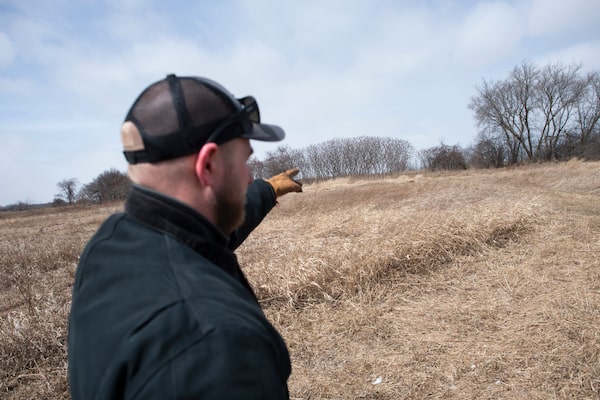
Ryan Johnstone points to corn that was used to trap wild boars near Pickering.Fred Lum/The Globe and Mail
In the end, it was the sweet fluffernutters.
Mr. Johnstone tried luring the wild boars with soured corn, with fermented soybeans, with stale baking and scraps from area farmers, but the land around was so lush with food and crops, none of it was as enticing as he needed it to be.
“Go sweet,” his American colleagues advised, and so he changed his approach. He discovered the boars liked vanilla, and he bought the local grocery store out of molasses and strawberry Jell-O. Peanut butter was great because he could smear it on a tree stump or stick, and the pigs would stay there working at it. Add gooey marshmallow fluff – for humans, a fluffernutter – and some soured corn, soybeans and whole peanuts, and they were hooked.
He’d been living and breathing the chase for weeks. Arranging his life around it, thinking about little else. It had been eye-opening, both about pigs and people. He’d encountered some who thought it was a conspiracy and that the government was releasing wild boars, others who believed government employees were somehow trying to keep the boars to hunt themselves.
But as weeks went on, and people saw the damage, they were starting to understand.
Sometimes, driving around looking for the sounder or watching videos from the trail cameras, he would marvel at the wild boars. There aren’t many animals you can drop into any environment, and have them not only survive, but adapt so well. Their success came at huge cost – property damage, the health of the ecosystem – but he couldn’t help but admire them, too.
As December approached, Mr. Johnstone started framing the Pig Brig. He worked slowly, building it piece by piece so the boars could get used to it, leaving it open for them to go in and out without fear. Then, with a cold front moving in, he set the trap. He caught 11 of them that night.
With the majority of their sounder captured, the remaining three became wary. They moved away from the area, and tore up a farmer’s yard. Mr. Johnstone set up a smaller trap at one of the other bait sites, adding more molasses and vanilla, and smearing gobs of peanut butter on the ground.
On Dec. 6, the trap sprung, capturing the final three. It was one month and one day since they’d been reported.
It had taken longer than he wanted, and the boars had caused quite a bit of damage, but still Mr. Johnstone considered it a success. He got them all, they didn’t reproduce and no one was hurt. Those were no small things.
In Ms. Delaney’s circles, there were some who didn’t agree with catching and killing the boars, but she knew it was the only way. She’d glimpsed what they could do, and understood how serious the problem could become. Plus, there were 15 million domestic pigs across the country in feedlots and farms. Before running free, however that came to be, the Pickering sounder was domestic, and would have been fated for the dinner plate.
“They got to be wild for a month, so don’t pity them,” she would tell people. “They got to be wild.”
Bonus: Jana G. Pruden on The Decibel
News stories about dangerous encounters between wild boars and humans sent Jana G. Pruden on a mission to find out more about them. On this episode of The Decibel, she explains what she learned and why it should worry us. Subscribe for more episodes.
Editor’s note: (June 20, 2022): Due to an editing error, Mary Delaney’s husband Joe Bezubiak was given the wrong surname.
 Jana G. Pruden
Jana G. Pruden